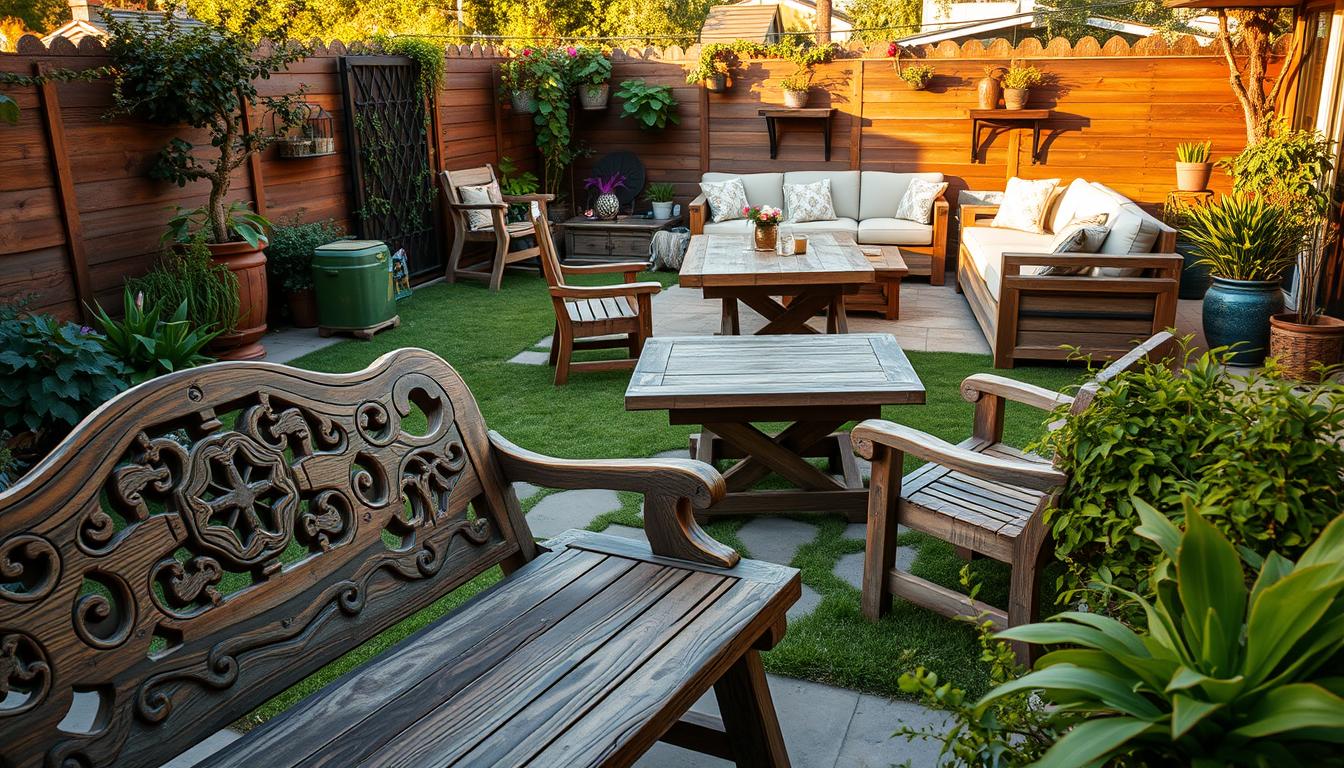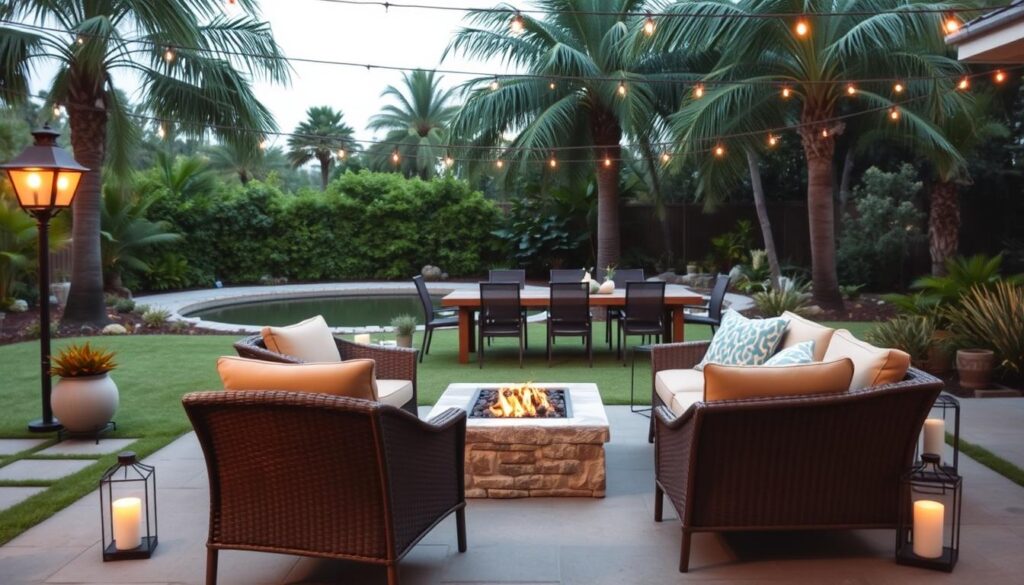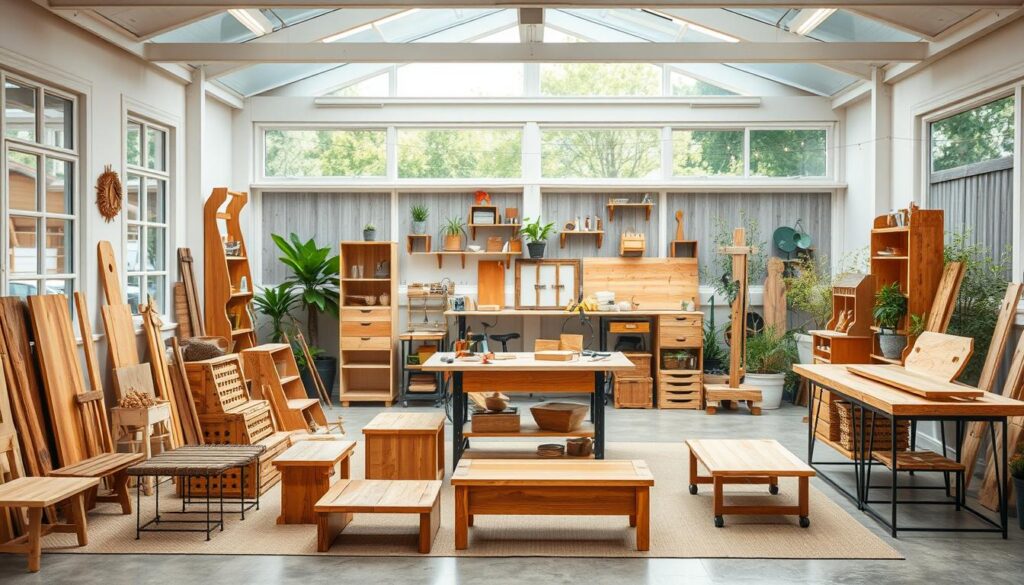
3 DIY Outdoor Furniture Projects to Elevate Your Patio Style
Are you tired of the same old patio setup? Wondering how to make it cozy without spending a lot?
Creating your own outdoor furniture is fun and rewarding. It lets you make your space your own and saves money.
Doing furniture projects adds a personal touch to your outdoor area. It makes it great for relaxing or hosting guests. With a DIY home decor project, you can make your patio more welcoming.
This article will show you three exciting projects. They’ll help you make your patio more stylish and inviting.
Project Overview: Why DIY Outdoor Furniture?
DIY outdoor furniture lets you make your outdoor space truly yours. You can design pieces that show off your style and fit your needs perfectly.
Benefits of DIY Outdoor Furniture
Do it yourself furniture means you can make something unique. Unlike store-bought furniture, you can customize every part to your liking.
This way, you can be creative and make sure your furniture works well for you.
Cost Savings and Customization
Building your own outdoor furniture can save money, too. Upcycled furniture projects use old materials, which cuts costs.
Plus, DIY lets you design furniture that fits your space and style exactly.
The Joy of Personalization
There’s happiness in making something yourself. Furniture renovation and DIY projects let you add your personal touch to your outdoor area.
This makes your space feel more like home and shows off your personality.
Materials You’ll Need for Your Projects
Success in DIY outdoor furniture projects depends on the right materials and tools. Whether making a rustic wooden pallet lounge chair or a modern cement block bench, knowing what you need is key. It makes the building process smooth and fun.
Common Tools for DIY Furniture
Having the right tools is essential for any DIY project. For outdoor furniture, you’ll need basic carpentry tools like a circular saw, drill, and hammer. A cordless drill is very useful because it’s versatile and easy to use. You’ll also need a tape measure, square, and level to ensure your projects are accurate.
For more complex projects, you might need specialized tools. For example, a jigsaw for curved cuts or a sander for smooth wood surfaces. Quality tools can greatly improve your project’s outcome.
Essential Materials for Durability
Durability is crucial for outdoor furniture. Choose materials that can handle different weather conditions. Weather-resistant woods like cedar and teak are great because they resist rot and insects. For cement or concrete projects, use a high-quality outdoor mix.
Don’t forget screws, nails, and wood glue. For outdoor use, use galvanized or stainless steel fasteners to avoid rust.
Eco-Friendly Options to Consider
Looking to reduce your environmental impact? There are eco-friendly options. Reclaimed or recycled wood adds a unique touch and reduces waste. Also, choose sustainable wood certified by organizations like the Forest Stewardship Council (FSC).
Consider eco-friendly finishes and treatments too. Natural oils and waxes protect wood without harmful chemicals. By choosing eco-friendly materials, you create durable and sustainable outdoor furniture.
Project 1: Rustic Wooden Pallet Lounge Chair
Get creative with DIY furniture by building a rustic wooden pallet lounge chair. It’s eco-friendly and stylish. This project is great for those who love upcycling and want to make their outdoor space unique.
Choosing the Right Pallets
The first step is to pick the right pallets. Look for sturdy pallets with a good texture. Make sure they are clean and dry to avoid problems during assembly.
Consider the type of wood and its condition when choosing pallets. Hardwoods like oak are more durable than softwoods. Also, check for any damage or rot.
| Pallet Type | Durability | Cost |
|---|---|---|
| Hardwood Pallets | High | Moderate to High |
| Softwood Pallets | Low to Moderate | Low to Moderate |
Assembly Steps and Tips
Assembling your pallet lounge chair involves several steps. Start by disassembling the pallets into individual planks. Then, cut the planks to the required size for your chair’s frame and seat.
Use a saw to cut the wood carefully, and ensure all edges are smooth to avoid splinters. Assemble the frame using screws or nails, and attach the seat and backrest.
Finishing Touches: Paint and Stain
Once your chair is assembled, you can add a finish to protect the wood and enhance its appearance. You can choose to paint or stain the wood, depending on your desired look.
Apply a primer first if you’re painting, and use a water-resistant stain if you prefer to maintain the wood’s natural look. Multiple coats may be necessary to achieve the desired finish.
Project 2: Modern Cement Block Bench
A modern cement block bench is a great addition to any outdoor space. It’s not just useful but also shows off your style. This DIY project is ideal for those who love the industrial look and want something that lasts.

Selecting the Right Cement Blocks
Choosing the right cement blocks is the first step. You need blocks that look good and can handle the outdoors. Think about the size and texture to match your design.
Durability is key; pick blocks that can stand up to weather. Also, consider the color and finish to match your outdoor decor.
Design Layout and Stability Tips
Planning your bench’s layout is important for looks and stability. Decide on the length and height based on your space and taste. A wider base helps with stability.
Make sure to properly level the ground before building. This prevents tilting. Anchoring the bench to the ground adds extra security.
Adding Cushions for Comfort
Adding cushions makes your cement block bench more comfy. Choose weather-resistant cushions that fit your decor. The right cushions can make your bench a cozy spot for relaxing or chatting.
When picking cushions, think about thickness and material. Thicker cushions are more comfy but shouldn’t hide the bench’s design. Use sun-resistant fabric for outdoor cushions.
Project 3: Upcycled Wine Barrel Table
Give old wine barrels a new life by turning them into beautiful tables for your outdoor space. This upcycled furniture project cuts down on waste and adds a special touch to your patio or garden.
Sourcing Wine Barrels
Finding the right barrels is the first step for your wine barrel table. Look for them at local wineries, online, or through classified ads. Choose a sturdy barrel with a lid to make the project easier.
Check the barrel for damage or rot. Make sure it’s clean and dry before starting. You might need to negotiate with sellers, like those at wineries.
Step-by-Step Conversion Process
To turn a wine barrel into a table, follow these steps. First, clean the barrel well to remove dirt. Then, remove the lid and any metal bands. You might need to cut the barrel in half for the table top.
Here’s a simple step-by-step guide:
- Clean and prepare the barrel
- Cut the barrel in half (if needed)
- Add a glass top or wooden slab for the table surface
- Attach legs for stability
- Finish with a protective coat
Decorative Ideas for Your Table
Once your table is built, add decorative touches to make it stand out. Consider a glass top for protection and easy cleaning. You can also add metalwork or paint for a personal touch.
For a rustic look, keep the barrel natural and add a clear coat. Add lighting or planters around the table for a cozy feel in your outdoor area.
Upcycling a wine barrel into a table is not just DIY home decor. It’s also a sustainable choice. This project shows how to give old materials a new life through furniture renovation.
Safety Tips for DIY Projects
When you start DIY furniture projects, safety comes first. A safe workspace keeps you safe and makes your DIY fun.
Essential Safety Gear to Wear
Wearing the right safety gear is key for DIY projects. You need protective eyewear, gloves, and a dust mask. Protective eyewear keeps your eyes safe from debris. Gloves help you grip and protect your hands. A dust mask stops you from breathing in dust.
| Safety Gear | Purpose | Benefits |
|---|---|---|
| Protective Eyewear | Shields eyes from debris and sawdust | Prevents eye injuries and infections |
| Gloves | Provides grip and hand protection | Reduces risk of cuts and abrasions |
| Dust Mask | Prevents inhalation of dust and particles | Protects respiratory health |

Safe Handling of Tools and Materials
Handling tools and materials safely is just as important. Always read the tool’s instructions and use the right tool for the job. Proper tool handling lowers accident risk and boosts your work quality.
Be careful with materials’ weight and size to avoid injury. Use the right lifting methods and ask for help when needed.
Maintaining Your DIY Furniture
Keeping your DIY outdoor furniture in good shape is essential. Regular care helps keep it looking and feeling new for years. It also makes your furniture last longer.
Weatherproofing Techniques
Weatherproofing is a must for your DIY outdoor furniture. It means using protective coatings to keep the material safe from rain, sun, and other weather. For wooden pieces, a waterproof sealant or stain can stop rot and fading. Apply a waterproof coating every year for the best protection.
Metal furniture needs rust-proof coatings, and fabric parts might need water-repellent treatments. Always check your furniture for wear and fix it quickly to avoid bigger problems.
Seasonal Maintenance Tips
Each season brings its own challenges for outdoor furniture. In spring, check for winter damage and fix it. Summer is for cleaning to avoid dirt buildup.
Fall is for getting your furniture ready for winter. Apply a protective coating or store it in a dry spot. Winter means checking for snow or ice damage.
By following these tips, you can make your DIY furniture last longer and look great all year.
Choosing the Right Location for Your Furniture
Finding the perfect spot for your DIY outdoor furniture is key to a welcoming outdoor area. The furniture’s location greatly impacts your patio or garden’s look and use.
Factors to Consider in Outdoor Spaces
When picking a spot for your outdoor furniture, several things matter. Think about the sunlight and shade patterns to keep your furniture comfy. Also, consider the wind direction to avoid drafts.
Other important factors include how close it is to your house, the view, and any landscaping. These all play a role in your outdoor space’s feel and function.
| Factor | Consideration | Benefit |
|---|---|---|
| Sunlight | Assess sunlight patterns | Comfortable seating areas |
| Wind Direction | Consider wind impact | Protected seating areas |
| Proximity to House | Balance distance and accessibility | Convenient and inviting |
Creating a Cozy and Functional Layout
To make your outdoor space cozy and useful, first figure out its main use. Will it be for eating, relaxing, or parties? Knowing this helps you arrange your furniture right.
Try making conversation circles with your seating. Make sure there’s enough room for people to move around easily.

A well-planned outdoor area can feel like an extra room of your home. It becomes a spot for both relaxation and fun. By choosing the right spot for your DIY furniture, you can make a beautiful and useful outdoor space.
Accessorizing Your Outdoor Space
Creating ambiance in your outdoor space is all about the details. This includes lighting and textiles. To make your patio cozy, focus on the right accessories. They should add comfort and show off your personal style.
Adding Throw Pillows and Blankets
Throw pillows and blankets are great for adding color, texture, and warmth. When picking throw pillows, think about your outdoor decor theme. Choose weather-resistant materials to stand up to the elements. Blankets add coziness on cool nights, making your space good for all seasons.
To look cohesive, pick pillows and blankets that match your furniture’s colors. For example, if your furniture is neutral, add colorful throw pillows. This lets you show off your style in your DIY home decor project.
Incorporating Lighting for Ambiance
Ambiance lighting can change your outdoor space, making it welcoming at night. String lights, lanterns, and solar lights are great for outdoors. They light up your patio and make it feel warm and inviting.
Plan your lighting based on your space’s layout and what you want to highlight. Use string lights for a canopy over a dining area or lanterns on tables for soft light. This careful lighting makes your outdoor space feel like part of your home.
Inspiring Design Ideas from Real Homes
DIY outdoor furniture can transform your backyard. Homeowners love to make their outdoor spaces unique. DIY projects add a personal touch.
Creating something special comes from being creative and having a clear idea. Looking at real homes can show you how to use different materials and designs. This way, you can make your outdoor space your own.
Successful DIY Projects
Many people have made their backyards better with DIY furniture. For example, a rustic wooden pallet lounge chair can make your patio cozy. These projects not only look good but also provide places to sit and eat.
Here are some inspiring examples:
| Project | Materials Used | Unique Feature |
|---|---|---|
| Modern Cement Block Bench | Cement blocks, wooden slats | Durable and weather-resistant |
| Upcycled Wine Barrel Table | Wine barrels, glass top | Elegant and eco-friendly |
| Rustic Pallet Lounge Chair | Wooden pallets, cushions | Cozy and budget-friendly |
Unique Designs and Finishes
The look of your DIY furniture can change your outdoor space a lot. Unique finishes, like weathered wood or bright paint, make your furniture stand out.
By focusing on unique designs and finishes, you can make your outdoor area welcoming. It can show off your personal style. Whether you like modern, rustic, or eclectic, there’s plenty of inspiration from real homes.
Troubleshooting Common Issues
Troubleshooting is key to keeping your DIY outdoor furniture in top shape. It ensures your furniture stays both functional and comfy. Even with the best care, problems can still pop up.
Common issues include damage, wear, and weathering. Fixing these problems quickly can make your furniture last longer and look better.
Fixing Structural Problems
Structural problems can come from many sources. These include bad assembly, too much weight, or harsh weather. To tackle these issues, first find out where the problem lies.
Check your furniture closely to see how bad the damage is. For small problems like loose screws, just tighten them up. But bigger issues might need rebuilding or replacing parts.
Addressing Weathering and Damage
Weathering and damage can really hurt your furniture’s look and life. Start by figuring out how bad the damage is.
For wood furniture, use weatherproofing methods like a waterproof sealant or stain. This helps protect it from more damage. For metal or plastic, clean it well and apply a protective coat to stop rust and fading.
Regular upkeep is crucial to avoid weathering and damage. By checking your furniture often and fixing problems fast, you can make it last longer and stay in great shape.
How to Share Your DIY Creations
Sharing your DIY projects can inspire others to try their hand at making something new. It helps build a community of creatives. By sharing, you show off your hard work and contribute to a culture of innovation.
Taking Great Photos of Your Projects
To share your DIY projects well, take clear photos from different angles. Good lighting is essential. Natural light makes your projects look better. Use a tripod for sharp photos and edit to improve colors and contrast.

Using Social Media to Showcase Your Work
Social media like Instagram, Facebook, and Pinterest are great for sharing your DIY work. Create an account for your DIY projects and post high-quality photos with detailed descriptions. Use hashtags to get more views and talk to your followers by replying to comments and messages.
Think about when you post to get more people to see your work. Consistency is key for a strong online presence. Join DIY groups or forums to meet others who like making things.
Final Thoughts: Enjoying Your Creation
Finishing a DIY furniture project is very rewarding. It feels great to see your work in your outdoor space. It’s a fulfilling feeling.
Creating something yourself adds a personal touch to your home. It also helps you grow as a person. When you enjoy your new furniture, think about sharing your story. This can inspire others to try DIY projects.
Personal Growth Through DIY
Working on furniture projects helps you learn new skills. It boosts your confidence in making things from scratch. This confidence can help you in many areas of life.
Sharing Your Creations
Sharing your DIY projects on social media or with loved ones can inspire others. It can start a chain reaction. More people might try DIY projects and enjoy the creative process.
Remember, the real value of DIY projects is in the journey, not just the end result. Enjoy your outdoor space and the pride of creating it.
Leave a Reply